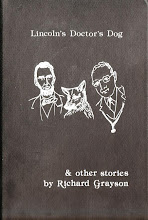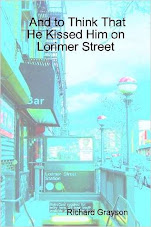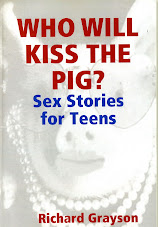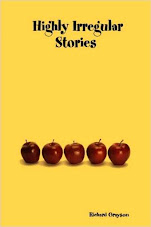
This report by Richard Grayson first appeared on Jeff Bryant's blog Syntax of Things (go there for the original links) on Tuesday, July 31, 2007:
Last evening, via the clattering G train (only line in the city that never sets metaphorical foot in Manhattan), and when it ends at New York's highest elevated subway station with its glorious skyline view, aboard the cozier F train for the two final stops, I traveled from my largely childless hipster 'hood of twentysomethings to Brooklyn's Stroller City of mommies and nannies, Park Slope -- famous for having more authors and book publishing people per capita than any other census tracks in these United States.
I'm here for a reading at the Slope's Barnes and Noble branch by Emily Mitchell, the British-born Brooklyn College MFA whose first novel, The Last Summer of the World, has just been published to a couple of excellent advance reviews:Publishers Weekly: (starred review) First-time novelist Mitchell pulls off the dazzling trick of allowing readers to see through the eyes of art-photography pioneer Edward Steichen in her excellent reconsideration of his life and art. This would be merely impressive if the book confined itself to the stormy end of Steichen’s first marriage, a sub-theme that gets its due and packs a psychological punch. Instead, Mitchell follows Steichen through his airborne reconnaissance work during WWI, providing a devastating portrait of the insanity of war in general and the Great War in particular. Throughout, individual photographs are described in detail, along with surprisingly rich narratives—some reconstructed, some imagined—filling in the stories behind the pictures. Most powerful are the descriptions of what Steichen saw from the air, such as his view of Americans chasing a group of Germans and killing them all, including one who tried to escape. The book offers up glimpses of Paris and the French countryside, including memorable scenes of Steichen’s visit to his good friend and mentor, sculptor August Rodin, but in the end, this commanding novel is about the images one can never quite burn from memory.
Library Journal: Mitchell presents a bittersweet first novel about famed photographer Edward Steichen and his experiences as an aerial photographer in France during World War I. While witnessing the horrors of war, Steichen remembers his earlier life in Europe and tries to understand the dissolution of his marriage. The flashbacks are framed by some of his early photographs, at times an awkward device, but on the whole Mitchell's prose is engaging and spirited. Perhaps owing to this stratagem, Steichen's celebrity circle is downplayed; the sculptor Rodin merits several scenes, but brother-in-law Carl Sandburg gets only the briefest allusions. Of course, Steichen himself along with his complicated past is the heart of the story. Mitchell, who has taught at Brooklyn College and Lehman College and published works in the Nation, the Indiana Review, and other journals, has written a striking novel highlighting the rich experiences of artists in Europe in the early 1900s and the inner life of a conflicted individual. Highly recommended for public and academic libraries.
Anyway, I get to the Barnes and Noble about ten minutes early and find a small crowd and folding chairs set up downstairs at the corner of New Age/Bibles and Spirituality/Astrology. I recognize Emily from her photo, though she's actually prettier in person. She seems to be talking to old friends from when she lived in New York. She says she's reading only in cities where she knows people who will show up. Some of her friends seem to be classmates from her time in the Brooklyn MFA. Michael Cunningham directs the fiction program now, and I wonder how much he's influenced Emily.
When I applied for Brooklyn's MFA program in 1974, I suspect they took just about everyone who wanted to go because it was the first year and people didn't know about it. Back then few people had even heard of an MFA.
I'm sure today my application would be rejected, as the competition is a lot more fierce. One of the best younger fiction writers I know, who was living in Brooklyn, wanted to go to BC but was rejected, so he had to go to his second choice -- Iowa! No kidding.
I think a lot of the success I had early in my career -- getting a commercial book published, getting state arts council grants, getting into the MacDowell Colony and other writers' retreats, getting my stories published in magazines -- stemmed from the lack of competition as opposed to today. It was simply easier because far fewer people were submitting and applying. For example, when I got my first individual artist fellowship from the Florida Arts Council in 1981, I'd been living in the state only a few months. But one out of three people who applied got the grants that year. By the late 1990s, when I served on panels evaluating the applicants, maybe one out of 25 got a fellowship. I had it a lot easier than writers starting today.
As the crowd gathers, I spot a couple of tykes in their menacing strollers, which I thought this store had banned from downstairs. Each of them appears to be asleep; however, I believe they have been trained to feign drowsiness by their mommies or literature-loving nannies and will awaken screaming at the most crucial section of Emily's reading.
I get a seat in the back. A crowd of about 40 or 45 is there now, and people in the back have to stand. As the community relations director asks us to start and gives us the usual drill about shutting cell phones and directions on where to line up to have our books signed after the reading ("along the Religion wall"), a guy plops down on the floor to my left. He looks a great deal like an extremely famous fortyish novelist, but I am trying not to stare so I can't be sure. The glasses don't look quite right, and it's a very typical New York "look," so it may be my imagination.
The bookstore community director, who's obviously read the novel (good sign), introduces Emily, who sets up the chapter she's going to read.
It takes place early in the novel, at the beginning of the 20th century, when Steichen is first engaged to Clara in Paris. They're with a bunch of their friends, including the woman who'll later figure in the infamous triangle that ends the marriage, as well as Leo Stein (Gertrude's brother) and others. It's evening, and they're going to walk to a cathedral. Edward realizes he wants to get his camera.
The prose is exquisite and sensitive. Written in the present tense and third person, the chapter switches point of view between Edward and Clara -- and it's clear only in the misunderstanding at the end how skillfully that was actually done. There's a delicious irony in the relationship between Clara and the woman who, years later, she will sue for alienation of Edward's affection.
Also, the chapter has interesting meditations on the role of the artist and in what ways he needs the support of others and whether the special nature of his role allows him to break ordinary rules of social conduct. The point of view is handed off gracefully from character to character, as in Virginia Woolf.
Steichen and his fellow reconnaissance bombers in World War I, working with new but untested technology (their planes were called "flying coffins") were photographing the world from above, seeing things from a perspective that no human beings had before. Steichen, better known today perhaps for his iconic portraits of Garbo, Churchill, Robeson, et al., was one of the first photographers to understand that the medium could be every bit as much great art as painting. In addition to Rodin, he knew many other artists and was the first person to introduce Brancusi and Matisse to American audiences.
The chapter has meditations on the nature of memory and also a beautiful passage explaining why Steichen prefers night photography -- the forms merely suggest themselves rather than appear in sharp detail, and that tells a better story, one more filled with mystery. But unlike with a lot of day photography, one can never be sure how a night photograph will come out.
Emily's conclusion is greeted with a round of applause, and she sits down to take a few questions. One person asks her about her work researching the characters, and Emily says she enjoyed doing research, especially when the writing got stuck because it gave her a feeling of progress, but at some point she realized that she'd have to stop researching and make things up. Indeed, the time frame of the novel is not quite like that of the events in real life. In some respects, she is lucky in that there are certain mysteries in Steichen's life; for instance, his biographers cannot agree if a particular love affair actually did take place or not, so she was free to decide for herself. Emily says she especially enjoyed going to the National Archives and reading the accounts of Steichen's fellow pilots from World War I.
Another audience member asks Emily about the use of photographs in the novel, and she says some of the ones she employs are actually composites of different Steichen photos from the period. Someone asks if Steichen has any descendants and if Emily talked to them, and she says he has a granddaughter who was involved in the making of a mid-1990s biography and that his third wife still lives in New York City.
"That's Joanna Steichen," the woman sitting next to me calls out. "I went to social work school with her in the 1970s." Emily says yes, that's the same woman.
Just as the community relations director, with no more hands up for questions, thanks Emily and starts to arrange for the book signings to proceed, one of the babies gives out a fearsome howl. Wow. These Park Slope mommies and nannies have them trained better than I thought. What self-control for a sixteen-month-old! Or maybe he was trying to get in one more question?
The man who may or may not be a famous novelist gets up from the floor and scampers away before I can get a close look.
Too cheap to buy a book -- I'm fourth in the reserve queue at the Brooklyn Public Library -- I leave the store and walk across the street to Methodist Hospital. Just near the entrance is the chapel where I like to visit this plaque commemorating a tragedy that happened just a few blocks away:
As usual, I tear up a little. It's a memorial to Stephen Baltz. Here's the Wikipedia entry on him:Stephen Baltz (1949-1960) was the only person to survive the crash of United Airlines Flight 826 after it collided with another plane on December 16, 1960, in a snowstorm over Staten Island. The eleven-year-old boy from Wilmette, Illinois was flying alone to meet his mother and sister, who flew in the day before; they were planning to spend Christmas in Yonkers with family. On impact with the ground, Baltz was thrown from the plane into a snowbank, where local residents rolled him in the snow to extinguish his burning clothing. Though alive and conscious following the crash, the boy was horribly burned and suffering from smoke inhalation. Stephen later died of his injuries in Park Slope's New York Methodist Hospital. A plaque was installed in the hospital's chapel in memory of the victims of this air disaster; part of the plaque contains sixty-five cents in blackened change from Stephen Baltz's pocket.
As a 9-year-old, I happened to be in the neighborhood on December 16, 1960. I tell what happened that day as I experienced it -- clumsily, awkwardly, because I can't write like Emily Mitchell -- in the final story of my last book. There's a version of "The Boy Who Fell to Brooklyn" from the University of Miami magazine Mangrove here, but luckily it seems to be in a yellow typeface that makes it unreadable.
Jason Sanford wrote a good poem called "Brooklyn Aircraft Disaster, 1960" here.
I guess what makes me especially sad tonight is that in a few years there'll be no one like me left, nobody who actually remembers that boy and that day of the crash.
But imagination can always replace memory if we want to capture the lost past, right?
Emily Mitchell does that in her novel, deftly capturing Edward Steichen in World War I as he returns to a place of memory and meaning.
And of course Edward Steichen captures lost moments in his photographs. Here's my favorite of his night photos of New York City. It's the Flatiron Building at the intersection of East 23rd Street, Fifth Avenue and Broadway, a place I've passed a hundred times but never quite have seen this way:
In my subway car on the way home, a cellist is playing Vivaldi. I don't have a one-dollar bill or even any quarters, but I give him nickels and dimes like the one in the hospital's memorial plaque.




































































